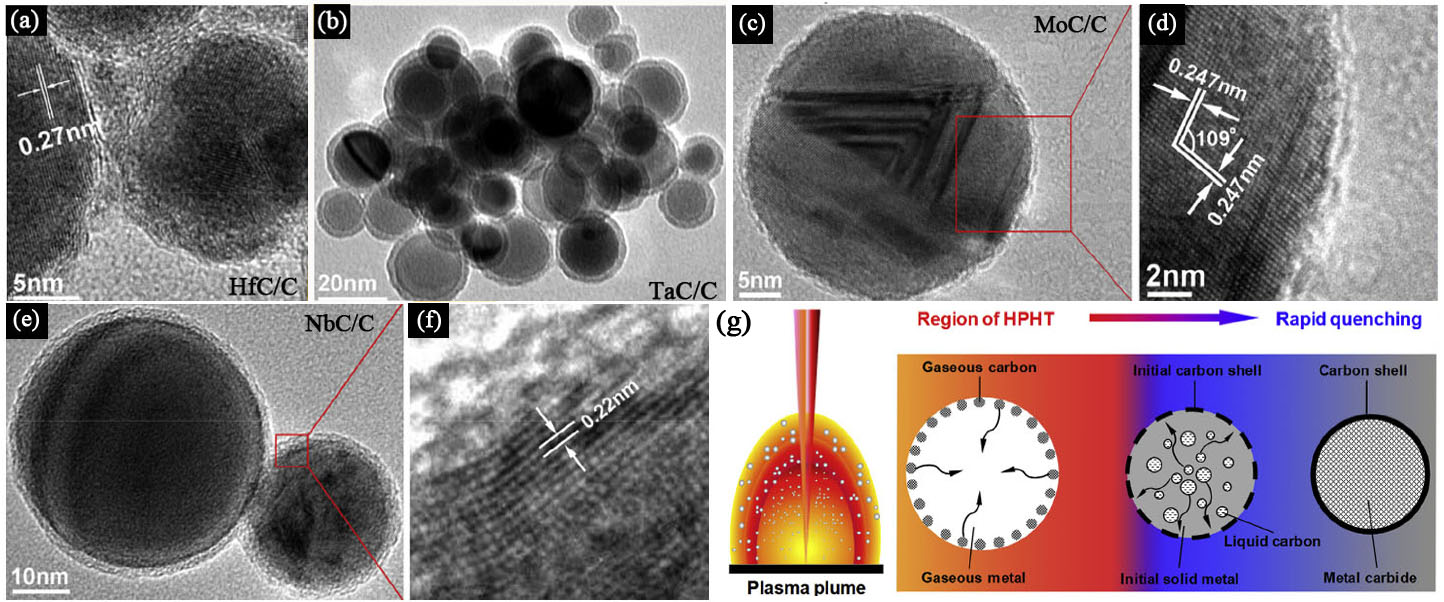Transition metal carbides (TMCs), mixing with coexistence of covalent, ionic and metal bonds, exhibit amazing physical and chemical properties. However, the preparing of carbides always undergo a process of oxidation and the presence of oxygen which prefer to affect the performance of metal-carbide coatings used in the fabrication of mechanical and electronic devices. Otherwise, the particle size of TMCs at nanoscale level could also result in the agglomeration of products, which leads to poor performance such as catalytic activities, and grain growth inhibitors. Fortunately, carbon materials with various architectures are considered as the ideal candidate for electrochemical energy devices in terms of high surface area, interconnected pore structure, and high electrical conductivity as well as environmental friendliness. While, obtaining carbon encapsulated TMCs using traditional methods usually involve poor controllability, high energy consumption, toxic gases production, and some byproducts generation.
In view of the opinions discussed above, a research group at Institute of Solid State Physics, Hefei Institutes of Physical Science, developed a simple and green technique to fabricate transition metal carbide (TMC)/carbon (C) core/shell nanospheres (NSs) by laser ablation of transition metals in acetone/ethanol liquid. Their study was published in journal of Carbon with title A general strategy toward transition metal carbide/carbon core/shell nanospheres and their application for supercapacitor electrode.
This technology of laser ablation in liquid (LAL) draws considerable attention from the scientific community because of its outstanding ability to fabricate various nanomaterials and nanostructures, such as hollow nanoparticles (NPs), core/shell NPs, quantum dots, and active colloids with high activity. Various TMC/C core/shell NSs such as TaC/C, NbC/C, HfC/C, and MoC/C core/shell NSs were successfully fabricated, highlighting the generality of this method.
It is noted that this is a general way for synthesis of TMC/C (Figure 1). Based on LAL technique, various carbon-related species (the predominant species) are produced through the decomposition of ethanol or acetone molecules, and formed a complex of carbon and metal in the gaseous state. Subsequently, the initially formed TMC NPs rapidly fuse/merge and grow. Benefited by the high temperature and high pressure (HTHP) conditions provided by the plasma plume-induced cavitation bubble, the initially formed TMC NPs evolve into TMC/C core/shell NSs because of partial precipitation of supersaturated carbon at lower HTHP.
Interestingly, all of the synthesized TMCs in the NS cores showed a cubic phase and structures similar to that of NaCl-type. The cores were further encapsulated by amorphous carbon shell with different thickness.
As an example of the functional properties of these compound materials, the obtained TaC/C core/shell NSs were investigated as a supercapacitor electrode, which showed a large specific capacitance, excellent rate capability and remarkable cycling ability, revealing that the NSs could be used as new electrode materials for electrochemical energy storage (Figure 2).
In addition, the photoluminescence of TaC/C core/shell NSs exhibited strong emission under the specific excitation wavelength at room temperature, showing potential biomedical applications due to the good biocompatibility of carbon shell.
This study was sponsored by the National Nature Science Foundation, National Key Basic Research of China, and the World Premier International (WPI) Center for Materials Nano-architectonics (MANA).

TEM image for different TMC/C core/shell structure: (a) HfC/C, (b) TaC/C, (c-d) MoC/C, (e-f) NbC/C; (g) Schematic illustration for the formation process of TMC/C core/shell NSs.(Image by YE Yixing)

(a) CV curves of the TaC/C core/shell NSs at different scan rates, (b) Charge/discharge curves for TaC/C core/shell NSs at various current densities, (c) Comparison of the specific capacitance of TaC/C core/shell NSs with other recently reported CDC and TaC nanowires/activated carbon, (d) Cycling performance of TaC/C core/shell NSs. (Image by YE Yixing)
Contact:
LIANG Changhao
Institute of Solid State Physics (http://english.issp.ac.cn/)
Hefei 230031, China.
Tel: +86 (0)551 65594860
E-mail: chliang@issp.ac.cn
 Tel: +86-551-65591206
Tel: +86-551-65591206
 Fax: +86-551-65591270
Fax: +86-551-65591270
 Emai: zhous@hfcas.ac.cn
Emai: zhous@hfcas.ac.cn
 350 Shushanhu Road
350 Shushanhu Road